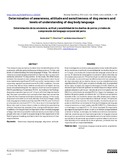Determination of awareness, attitude and sensitiveness of dog owners and levels of understanding of dog body language

Voir/
Date
2023Palabras Clave
Conciencia, Lenguaje corporal canino, Propietario, ActitudAwareness, Dog body language, Dog owner, Attitude
Metadatos
Afficher la notice complèteRésumé
This research was carried out to determine the identification of the
awareness, attitude and sensitiveness of dog owners in Türkiye, and
levels of understanding the body language of dogs. The research
material consisted of data obtained from face-to-face surveys with
randomly selected 172 dog owners. In the study, the differences
between the education level categories of dog owners were found
to be statistically significant (P<0.01), but not for marital status, child
ownership, age and household income (P>0.05). In addition, the rate
of those who did not have children was found to be higher among
those who adopted dogs for the reasons of animal love/compassion
(58.6%) and feeling of loneliness (75.0%). According to the findings,
dog owners spend a maximum of 1-2 hours with their dogs during the
day. Men have more difficulty in caring for their dogs than women due
to lack of time, financial constraints and other reasons. In this study,
dog owners were able to correctly identify 10 of the 20 images of dog
body language at a medium and high level (50.0-95.3%), and 10 of them
at a low and very low level (47.7-4.1%). As a result; It is important for
those who want to have a dog to make an attempt by questioning
whether they have the necessary time, energy and financial means.
In addition, it is thought that it is important to learn the body language
of dogs, that there is a need for institutional structures that will help
people who own or want to acquire dogs in this regard and in the
field of general breeding, and teach them the requirements of their
responsibilities.
Colecciones
Información Adicional
| Otros Títulos | Determinación de la conciencia, actitud y sensibilidad de los dueños de perros y niveles de comprensión del lenguaje corporal del perro |
| Correo Electrónico | iseker52@gmail.com |
| Editor | SaberULA |
| ISSN | 0798-2259 |
| ISSN Electrónico | 2477-944X |
| Resumen en otro Idioma | Esta investigación se llevó a cabo para determinar la identificación de la conciencia, la actitud y la sensibilidad de los dueños de perros en Turquía, y los niveles de comprensión del lenguaje corporal de los perros. El material de investigación consistió en datos obtenidos de encuestas cara a cara con 172 dueños de perros seleccionados al azar. En el estudio, se encontró que las diferencias entre las categorías de nivel educativo de los dueños de perros eran estadísticamente significativas (P<0,01), pero no para el estado civil, la propiedad de los hijos, la edad y los ingresos del hogar (P>0,05). Además, se encontró que la tasa de quienes no tenían hijos era mayor entre quienes adoptaron perros por razones de amor/compasión animal (58,6 %) y sentimiento de soledad (75,0 %). Según los hallazgos, los dueños de perros pasan un máximo de 1 a 2 horas con sus perros durante el día. Los hombres tienen más dificultades para cuidar a sus perros que las mujeres debido a la falta de tiempo, limitaciones financieras y otras razones. En este estudio, los dueños de perros pudieron identificar correctamente 10 de las 20 imágenes del lenguaje corporal canino en un nivel medio y alto (50,0-95,3 %), y 10 de ellas en un nivel bajo y muy bajo (47,7-4,1 %). Como resultado: Es importante que aquellos que quieren tener un perro lo intenten preguntándose si tienen el tiempo, la energía y los medios económicos necesarios. Además, se piensa que es importante aprender el lenguaje corporal de los perros, que existe la necesidad de estructuras institucionales que ayuden a las personas que poseen o quieren adquirir perros en este sentido y en el campo de la cría en general, y enseñar ellos los requisitos de sus responsabilidades. |
| Colación | 1-10 |
| País | Venezuela |
| Institución | Universidad del Zulia (LUZ) Universidad de Los Andes (ULA) |
| Publicación Electrónica | Revista Científica |
| Sección | Revista Científica: Artículos |





